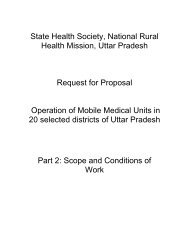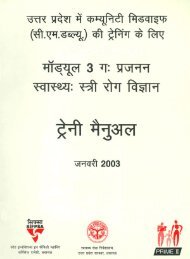MODULE 1: Infection Control and Waste Management - State ...
MODULE 1: Infection Control and Waste Management - State ...
MODULE 1: Infection Control and Waste Management - State ...
You also want an ePaper? Increase the reach of your titles
YUMPU automatically turns print PDFs into web optimized ePapers that Google loves.
• Transportation – The waste should be transferred into covered containers/ cartsto the waste collection area. Routes <strong>and</strong> timings of transporting waste should besuch to avoid client care areas <strong>and</strong> waiting areas.• Storage – Place the waste in an area which is away from the Client care area <strong>and</strong>the waste should be stored in separate covered bins. The place or room should bekept free from insects, rodents <strong>and</strong> other animals.• Disposal – The waste should be disposed to the waste collection agency everydayor as decided in the contract with agency <strong>and</strong> proper record should be maintainedfor disposal.2.1.3 Sharp <strong>Waste</strong> DisposalDispose all the sharp items in puncture proof containers. For puncture proof containers,boxes of heavy cardboard, tin can with lid, thick plastic bottles with small opening can beused. These containers should be kept close to all the points where some procedure isbeing performed <strong>and</strong> one such container should also be kept in the laundry, for disposalof sharps found in linen. It should be seen that –• Containers should be emptied when three-quarters full.• Always wear thick utility gloves while h<strong>and</strong>ling the sharps.• Sharps should not be destroyed by burning, except in large incinerators.• Dispose the containers either by giving it to the waste disposal agency or by deepburial.• To reduce needle stick injuries, do not recap, bend, or break needles or removethe needles from syringes before disposal. Needles should either be burnt inneedle burners or should be disposed as described above.2.1.4 Liquid Medical <strong>Waste</strong> DisposalLiquid waste can be blood, urine, vomit or any other body fluid.• Always wear thick utility gloves when h<strong>and</strong>ling or transporting liquid medicalwaste of any kind.• When carrying or disposing liquid medical waste, be careful to avoid splashingthe waste on yourself, others or surfaces.• Carefully pour liquid waste down the toilet or latrine.• Rinse the toilet or sink thoroughly with water to remove residual waste.• Clean with a disinfectant cleaning solution at the end of each day.• Decontaminate the container that held the liquid waste by soaking it for 10minutes in a 0.5% chlorine solution before washing.• Wash h<strong>and</strong>s, decontaminate gloves <strong>and</strong> wash them.Hazardous <strong>Waste</strong>:• Cleaning solutions <strong>and</strong> disinfectants such as glutaraldehyde should be h<strong>and</strong>led asdescribed above as liquid medical waste.• Rinse containers thoroughly <strong>and</strong> reuse after washing with detergent <strong>and</strong> water.44










